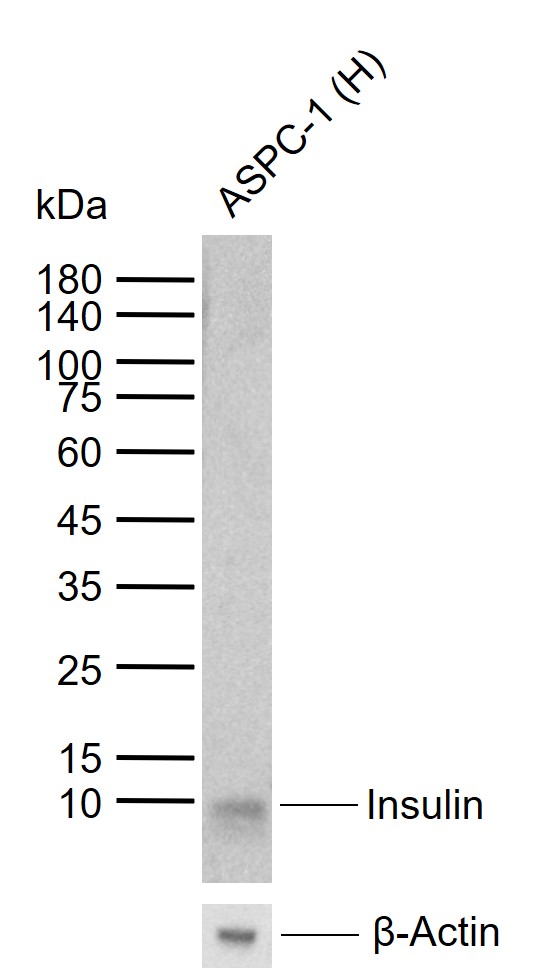
Mouse Anti-Insulin (1G11)antibody
ILPR; INS; Insulin A chain; Insulin B chain; Insulin A chain; Insulin precursor; IRDN; Proinsulin; Proinsulin precursor; IDDM2; INS_HUMAN; MODY10.
View History [Clear]
Details
Product Name Insulin (1G11) Chinese Name 胰岛素单克隆抗体 Alias ILPR; INS; Insulin A chain; Insulin B chain; Insulin A chain; Insulin precursor; IRDN; Proinsulin; Proinsulin precursor; IDDM2; INS_HUMAN; MODY10. Research Area Tumour Cardiovascular Cell biology Neurobiology Signal transduction Growth factors and hormones Diabetes Endocrinopathy The new supersedes the old Immunogen Species Mouse Clonality Monoclonal Clone NO. 1G11 React Species Human, Applications WB=1:500-2000 ELISA=1:5000-10000
not yet tested in other applications.
optimal dilutions/concentrations should be determined by the end user.Theoretical molecular weight 5.8/12kDa Cellular localization Secretory protein Form Liquid Concentration 1mg/ml immunogen Recombinded human Insulin protein Lsotype IgG1 Purification affinity purified by Protein A Buffer Solution 0.01M TBS(pH7.4) with 1% BSA, 0.03% Proclin300 and 50% Glycerol. Storage Shipped at 4℃. Store at -20 °C for one year. Avoid repeated freeze/thaw cycles. Attention This product as supplied is intended for research use only, not for use in human, therapeutic or diagnostic applications. PubMed PubMed Product Detail Insulin is a pancreatic hormone that regulates glucose and is involved in the synthesis of protein and fat. It increases cell permeability to monosaccharides, amino acids and fatty acids. It accelerates glycolysis, the pentose phosphate cycle, and glycogen synthesis in liver. Heterodimer of a B chain and an A chain linked by two disulfide bonds.Belongs to the insulin family. The insulin-link growth factors, IGF-I and IGF-II (also desinated somatomedin C and multiplication stimulating activator, respectvely), share approximatly 76% sequence identity and are 50% related to pro-insulin.IGF-I and IGF-II are nonglycosylated, single chain proteins of 70 and 76 amino acids in length, respectivelly. IGF-I functions as an autocrine regulator of growth in vaious, whereas the function of IGF-II is less well defined.
Function:
Insulin decreases blood glucose concentration. It increases cell permeability to monosaccharides, amino acids and fatty acids. It accelerates glycolysis, the pentose phosphate cycle, and glycogen synthesis in liver.
Subunit:
Heterodimer of a B chain and an A chain linked by two disulfide bonds.
Subcellular Location:
Secreted.
DISEASE:
Hyperproinsulinemia, familial (FHPRI) [MIM:176730]: An autosomal dominant condition characterized by elevated levels of serum proinsulin-like material. Note=The disease is caused by mutations affecting the gene represented in this entry.
Diabetes mellitus, insulin-dependent, 2 (IDDM2) [MIM:125852]: A multifactorial disorder of glucose homeostasis that is characterized by susceptibility to ketoacidosis in the absence of insulin therapy. Clinical fetaures are polydipsia, polyphagia and polyuria which result from hyperglycemia-induced osmotic diuresis and secondary thirst. These derangements result in long-term complications that affect the eyes, kidneys, nerves, and blood vessels. Note=The disease is caused by mutations affecting the gene represented in this entry.
Diabetes mellitus, permanent neonatal (PNDM) [MIM:606176]: A rare form of diabetes distinct from childhood-onset autoimmune diabetes mellitus type 1. It is characterized by insulin-requiring hyperglycemia that is diagnosed within the first months of life. Permanent neonatal diabetes requires lifelong therapy. Note=The disease is caused by mutations affecting the gene represented in this entry.
Maturity-onset diabetes of the young 10 (MODY10) [MIM:613370]: A form of diabetes that is characterized by an autosomal dominant mode of inheritance, onset in childhood or early adulthood (usually before 25 years of age), a primary defect in insulin secretion and frequent insulin-independence at the beginning of the disease. Note=The disease is caused by mutations affecting the gene represented in this entry.
Similarity:
Belongs to the insulin family.
SWISS:
P01308
Gene ID:
3630
Database links:
Entrez Gene: 3630 Human
Entrez Gene: 16333 Mouse
Entrez Gene: 16334 Mouse
Omim: 176730 Human
SwissProt: P01308 Human
SwissProt: P01325 Mouse
Unigene: 272259 Human
胰岛素(Isulin)胰岛素抗体是胰岛细胞分泌得一种激素,可以减底血糖浓度。此抗体和人胰岛素反应,并与大多数哺乳类动物的胰岛素有React Species,主要用于胰岛细胞瘤的功能性研究。Product Picture
Bought notes(bought amounts latest0)
No one bought this product
User Comment(Total0User Comment Num)
- No comment



 +86 571 56623320
+86 571 56623320
 +86 18668110335
+86 18668110335

